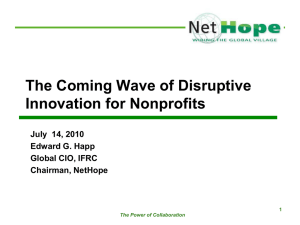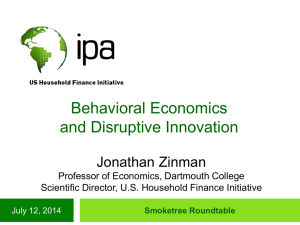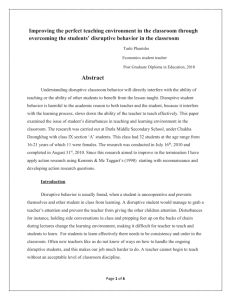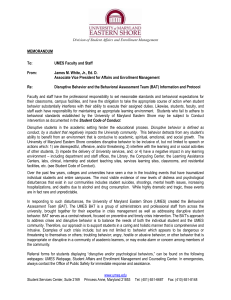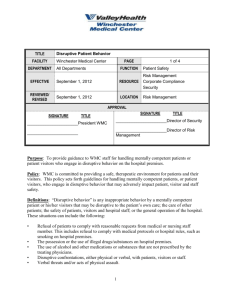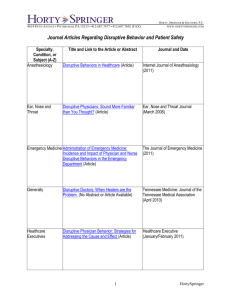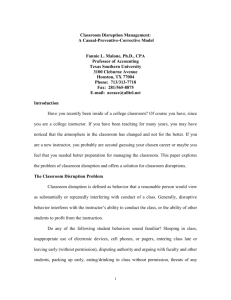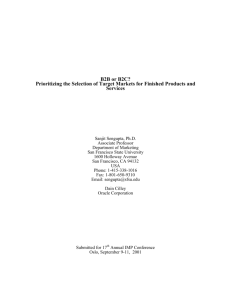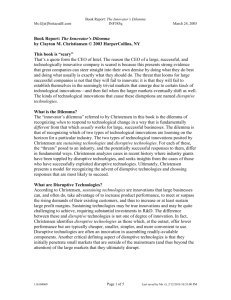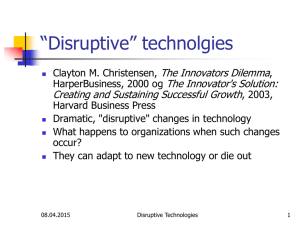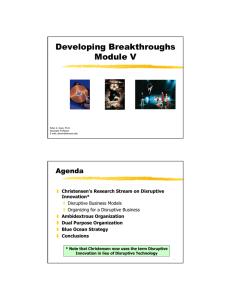Finding Opportunity in Demographic Change
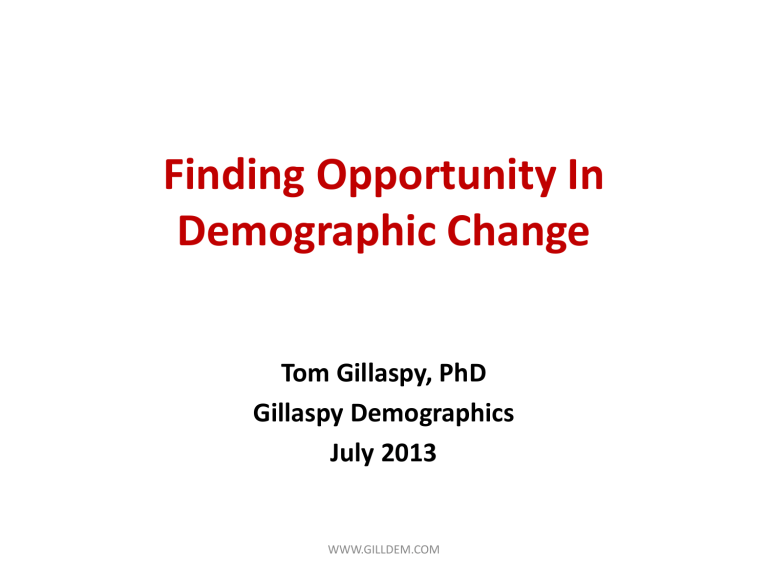
Finding Opportunity In
Demographic Change
Tom Gillaspy, PhD
Gillaspy Demographics
July 2013
WWW.GILLDEM.COM
The World Is Entering An Unprecedented Time
Of Great Risks And Even Greater Opportunities
Population growth is slowing but we may still add about 1 to 4 billion to our existing 7 billion
Low and declining fertility rates result in the population aging for the first time in history
Rising incomes result in increased global demand for food; quantity and quality
Supply of labor is a growing global issue for economic growth
WWW.GILLDEM.COM
The Demographic History Of The U.S.
After World War II
Roller coaster births leading to dramatic differences in generation sizes
Rapidly expanding workforce (youth and women)
Outward expansion into new suburban areas with central city and rural decline
Growth of the sunbelt at the expense of the
Northeast and Midwest
More diverse
More urban—less rural, less farm & more misunderstanding
WWW.GILLDEM.COM
2008 Was A Watershed Year!
•
The Great Recession
Housing market collapse—rapidly growing area quit growing
Weak balance sheets and hidden risks exposed
Labor market upended, delaying much consumption activity.
•
The Gray Tsunami
Government debt issues exposed
Will increase the demand for government services while limiting growth of revenue
Will contribute to slower economic growth and slower growth in rapidly growing areas.
WWW.GILLDEM.COM
This Decade, The United States Will Add As Many
People 65+ As We Have In The Past Three
Decades Combined
WWW.GILLDEM.COM
US Labor Force Growth Will Be At Record Low
Levels Be The End Of This Decade
US Bureau of Labor Statistics forecast
WWW.GILLDEM.COM
The Ratio of Middle-aged (40-49) to Older (60-69)
Explains About 60% Of The Variation In P/E Since The Early 1950s
Currently at 16.44, This Model Predicts It To Drop To About 8 By End of Decade
WWW.GILLDEM.COM
Growth Of The Working Age Population Is Slowing Or
Declining In Most Industrialized Nations Which Will Be A
Drag On Economic Growth
US Census Bureau International Data Base
WWW.GILLDEM.COM
Overall US Economic Growth Slows As
Labor Force Growth Slows
US BEA, McKinsey Global Institute, We will need a 2.3% annual increase in productivity just to reach our 20 year average growth of 2.8%
WWW.GILLDEM.COM
Productivity Is Not Just Making Things
•
Productivity is also
Cheaper
Making things better— Quality
Examples; the best implantable devices made, glue that always performs to standards, lower incidence of MRSA in hospitals
Making better things— Innovation
Examples; switch from hard drives with moving parts to solid state, driverless automobiles, new cures for diseases
(Alzheimer's?)
The pressure for disruptive innovation is increasing
WWW.GILLDEM.COM
Global Agriculture Productivity Continues To Increase
WWW.GILLDEM.COM
Grain Prices Have Been On A Long Run Down Trend,
But There Are Signs This Is Changing
WWW.GILLDEM.COM
Percent Of Employers Having Difficulty Filling
Jobs Due To Lack Of Available Talent
90%
80%
70%
60%
50%
40%
30%
20%
10%
0%
34%
49%
48%
42%
81%
22%
43%
71%
World US India Germany Japan China Mexico Brazil
Manpower Group, 2012 Talent Shortage Survey
WWW.GILLDEM.COM
The “New Normal” Probably Means
•
Slower global economic growth
•
The land/rent gradient will shift
•
Talent will be the scarce resources
•
A single-minded focus on productivity
•
Governments will worry about how to pay for past promises
•
Government service cuts, courtroom delays, permitting delays
•
More frequent disruptive events/innovations with larger impact on business
•
A whole new set of challenges and opportunities
•
Some will fall due to the Tyranny of Success. New economic leaders will emerge
WWW.GILLDEM.COM
Commodity Price Cycles—Are Grains
Poised For A Long Run Increase?
•
In a paper "From Boom to Bust: A Typology of Real
Commodity Prices in the Long Run," David S Jacks looks at the cycles the asset class have undergone in the past 160 years.
•
He found that the real value of 30 commodities studied had, by the end of 2011, rapidly increased since 1900.
•
Prices for resources that can be grown have trended downwards. The inflation-adjusted prices of rice, corn and wheat are lower now than they were in 1950.
•
There are signs that this may be reversing for grains
•
Although the global population is 2.8 times above its 1950 level, world grain production is 3.6 times higher.
WWW.GILLDEM.COM
UN 2012 Projected World Population
(in billions)
12
10
8
6
4
2
0
Medium fertility
Low fertility
Current fertility about 2.5 down from 4.97 in 1950. Low variant in 2100 1.51, medium 1.99
WWW.GILLDEM.COM
David Jacks Research On Long Cycles In Prices
Re Economists Magazine June 12, 2013
WWW.GILLDEM.COM
The Market For Ag Products Will Be
Driven By Strong Forces
Supply
•
New technology continues to be developed
•
Great potential to push existing further
•
Reducing waste in the supply chain has great potential
•
Water, climate and disease are major concerns
Demand
•
Population will increase—more mouths
•
Incomes will increase—better and richer diets
WWW.GILLDEM.COM
Avoiding The Tyranny of Success Will Be
Difficult For Both Private And Public Sectors
The impact of disruptive events will increase with the drive to increasingly lean operations.
The global imperative to increase productivity will accelerate the pace of disruptive innovation.
Conflict between the lean/quality based productivity improvement and the innovation side of the organization will increase.
WWW.GILLDEM.COM
The Third Industrial Revolution Is
Transforming Economic Activity
Advances in robotics, 3D printing, materials, software, bioengineering, and the web are fundamentally changing where and how economic activity takes place.
Innovation is replacing physical capital as the foundation of economic growth.
Physical location will be less important and those bound to it will find competition increasingly difficult.
The pace of disruptive innovation will increase
WWW.GILLDEM.COM
In A World Driven By Rapid Change Resulting
From Demographic Pressures--Some Critical
Issues For The Next Decade
• Place (physical and financial capital) will be less important
• Manufacturing will happen everywhere there are talented people
• Energy, food and water will be critical resources
WWW.GILLDEM.COM
Some Key Conclusions For The Rest Of
This Decade
Long run economic growth will slow globally so expectations of rates of return should be moderated.
Increased consumption in China and India and sovereign debt issues in the wealthier nations will lead to rising interest rates
Slower labor force growth will focus economic growth on productivity improvements
Talent will be the limiting factor to growth
Innovation will displace Lean and Six Sigma in the drive to increase productivity.
Some will thrive in this environment—others not
WWW.GILLDEM.COM
Some Key Conclusions For The Rest Of
This Decade 2
Austerity (an “obvious” solution) will be counter productive leading to slower growth or decline
Tradition-bound institutions will see dramatic changes
(eg., courts and legal system)
Unmet expectations, changing social contract and lost
American Dream will lead to unrest
The unrest is caused by global forces but will be focused locally—governments and businesses will be blamed.
Consumption patterns will change and with them markets
Some will thrive in this environment—others not
WWW.GILLDEM.COM
What Should Keep Your Clients Awake At Night
Creative Destruction/Disruptive Innovation
Forces for change are heightened during periods of economic stress
Disruptive changes are not evolutionary
Some game changers will occur
There will be short term losers as well as winners
Winners are often those who change the rules of the game—David versus Goliath
WWW.GILLDEM.COM
The Market For Ag Products Will Be
Driven By Strong Forces
Supply
•
New technology continues to be developed
•
Great potential to push existing further
•
Reducing waste in the supply chain has great potential
•
Water, climate and disease are major concerns
Demand
•
Population will increase—more mouths
•
Incomes will increase—better and richer diets
WWW.GILLDEM.COM
“ I skate to where the puck will be, not to where it has been.”
Wayne Gretzky
Famous Canadian Philosopher
WWW.GILLDEM.COM







